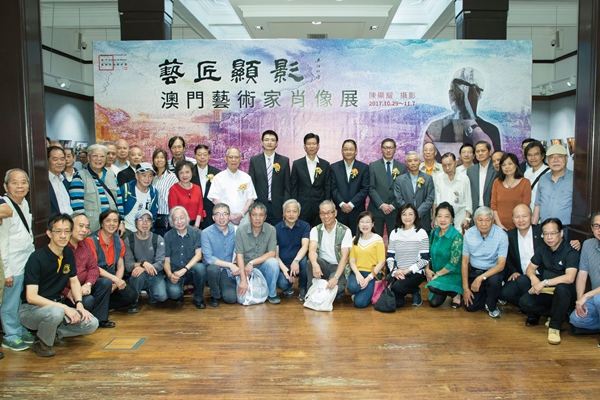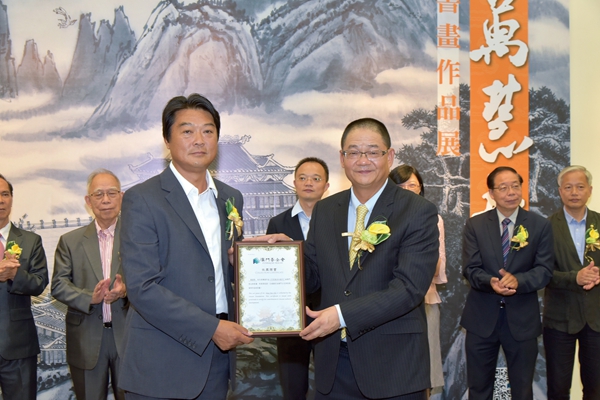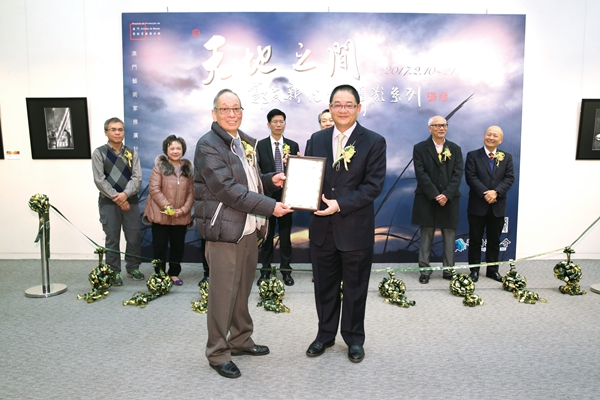We shall appear at any place in need of us
Exclusive interview with WU Zhiliang, Chairman of Executive Committee of Macao Foundation

Launching Ceremony of Fruit FUN Enjoyment Day hosted by Macao Foundation

Group photo of artists from Macao after opening ceremony of Image of Artists Exhibition

WU Zhiliang, Chairman of Executive Committee of Macao Foundation presents complimentary collection certificate to artists in Macao Artists Promotion Program

WU Zhiliang, Chairman of Executive Committee of Macao Foundation presents works collection certificate to photographer GUO Xiangxin in Macao Artists Promotion Program
Important task of inheritance and development of art in Macao falls on the shoulders of creative people.
Journalist (Hereinafter referred to as J): The MAPP and PMLS have been carried out for many years. What are your initial purposes of these two projects?
WU Zhiliang (Hereinafter referred to as WU): A city needs spirituality. In the past 30 years, Macao has accumulated considerable achievements in artistic creation. After nearly three decades of exploration, a group of outstanding artists emerged in the mid-1980s has now become the backbone of the art in Macao, leading the vogue. This group of people, with abundant life experience and improving artistic attainments, has fascinating charms through the materialized images. On the other hand, with the popularization of higher education in the past decade, local art creations have gradually become more specialized and pluralistic, with continuous emergence of newcomers, bringing brandnew artistic trends, creative techniques, visual elements and appreciation manner.However, due to the lack of systematic promotion, the overall image of Macao artists is not yet clear enough, and its contribution to the development of urban culture and the arts has not received enough attention and commendation. The Macao Foundation is dedicated to promoting Macao's local arts and cultural activities and creating a platform for artists to enhance their artistic qualities. To this end, we have launched the MAPP and invited senior and young artists from Macao to participate in the project. The consideration concerning invitation, based on the accomplishments of artists and the quality of their works, is committed to creating a vivid group of portraits for the quietly working Macao artists.
The Produced in Macao of PMLSrefers to performances of loal organizations, and those of local and foreign groups, adhering to the essence of from the public and back to the public, receiving the public's support and appreciation; the Local Sentiment is to express the feelings of national identification of people in the city, praising the enchanting charms of our city gathering both the Chinese and Western cultures, the profound Chinese culturewhile showcase the world our high degree of humanistic concern and Macao's fascinating cultural landscape.
J: In your opinion, what is the positive significance of these projects for the cultural construction in Macao?
WU: The people of Macao hope that the creators and societies of visual arts and stage arts will provide public cultural products of higher quality. By the end of 2017, the MAPP has completed the exhibition and promotion of 71 artists. We hope to organize exhibitions for Macao artists, publish catalogs, and create a group portrait of Macao artists as a whole in a systematical manner, meanwhile, hoping that they will continue their creation with constant artistic improvement. The implementation of the MAPP will revitalize the atmosphere of artistic creation in Macao, examine the current level of art creation, deepen the arts education, shape the image of a cultural city, publicize the urban cultural character and play a positive role in arousing the public's attention and support to the cultural and creative industries.The original intention of PMLS is to display the group image of local performing arts troupes, amplify the functions of community activities and demonstrate the status of culture in the life of citizens via setting up the stage by the Foundation with community performance so as to eventually realize the target of inheritance of culture, continuation of context, union of people and enhancement of sense of belongings. Every year, there are hundreds of application projects for the PMLS, but of uneven levels. It is our hope that, through professional review and selection each year, more than ten performances will be selected with more support and resources to promote the art programs to further specialization. In addition to supporting and encouraging local arts and cultural troupes to produce better and more exciting programs, PMLS also provides more performing opportunities for local youth artists to take the lead in performing arts and enhancing their performing standards. More importantly, they are encouraged to get closer to the community and make full use of community cultural facilities with the purpose of approaching the public, enhancing the interaction between the performing arts groups and the public, enabling the public to enjoy a higher standard of local arts performances, raising their interest and appreciation for the performing arts, enrich theing cultural life of the community, creating an active community culture and building the image of a dynamic city.
While promoting these two projects, we also did not reduce the support for other works of art and performances not included in the project: the number of visual art exhibitions we support each year is basically over ten times that of the MAPP. We also conduct 8 to 10 art exchange programs each year by inviting foreign artists to make exhibitions in Macao and encouraging Macao artists to go out, for example, the cooperation with China Federation of Literary and Art Circles and the exchanging projects in Ningxia in 2016 and Hunan in 2017. It is the same for the performance projects, which encourage more artists to provide more performances. For example, more than 200 performances of Cantonese Opera are performed every year. Art groups from other places are also invited to perform in Macao.
J: As the foundation's projects are more directed at local artists and art associations in Macao, have you considered more art projects from the Mainland or other countries?
WU: There aren’t many projects of this type at present. The specific reason is that there are not many projects in Macao that have competitive advantages, but only a small number of full-time artists and writers, most of whom are amateurs. As a result, the exchanges have shown unequal status. There are not many groups that we can send out in Macao. However, there are many artists and organizations who want to come to Macao for exhibitions. This is an objective phenomenon. However, we encourage exchanges between artists and art organizations from different regions. For example, our cooperation with China's Federation of Literary and Art Circles, we contact a province every year and conduct a cooperative exhibition. We look forward to learning from each other and reaching more exchanges. For more than a decade, it has witnessed a very satisfactory result as we have invited the China Beijing Opera Arts Foundation and the National Ballet of China to come to Macao and perform in the campus each year.
No participation into the implementation of fundedprojects, only assess the results and effectiveness of thepartnership
J: There are more than 8000 local groups in Macao. What kind of standards and principles will the Macao Foundation choose to cooperate with?
WU: There are three major criteria: firstly, find out the social benefits and significance of this project; secondly, groups with relatively large scale and long history are naturally to be selected, in other words, its capacity of project execution is also important; thirdly, evaluate the rationality of the specific project budget.
J: Some groups have been able to obtain funding support from the Foundation for several years in a row. Some may have been funded for the first time or never. What types of arts groups are more likely to be selected? What are their characteristics? What are the requirements to be met by artists involved in the promotion by the Foundation?
WU: Many small groups encounter much difficulty when it comes to running projects - not only financially, but also obviously remains powerless to organize and implement. Therefore, when we work with art groups, it mainly focuses on project-led issues, we hope that there will be cooperation among similar and homogeneous groups in Macao because cross-cutting membership in Macao's groups is most common.
J: You once mentioned that you do not want the relationship between the Foundation and groups to be just "giving" and "accepting": it is not just for the Foundation to provide funds, and the groups to be responsible for implementation, but for training more talents through the group, hoping that the activities of the groups would benefit more citizens. What is the current funding model? is it getting out of the relationship abovementioned?
WU: Macao Foundation's main working methods and ideas have always been "make up for missing"--- we shall appear at any place in need of us. The relationship between the Foundation and groups is a partnership, which will not participate in the implementation of the funded projects. We will only evaluate its outcome and effectiveness. However, we are most willing to provide assistance to some of the projects that work closely with us or ask the Foundation to make suggestion.
J: In your observations, what are the room and orientation for the improvement in the creative projects of the Macao art groups?
WU: The Macao Foundation subsidizes about 2,500 projects each year, and some of these phenomena require our attention. Firstly, what is the original intention of each group? A society has been established for a long time, and the original intention of the establishment of the group has been forgotten, the project does not match the purpose of the group, for instance, a group of calligraphy and painting artists suddenly go to hold a concert, a group of Cantonese opera suddenly went to organize exhibitions. The development of these groups has begun to show some disorder in these years. We have no power to intervene. However, they do not contribute too much to the overall progress of Macao society. We encourage more similar groups and those of diversity to coordinate their efforts and concentrate their resources on enhancing the scale, level and quality of the projects so as to offer more high-quality public products to the community. Secondly, the homogenization of the project is more obvious. Some groups do projects just for the purpose of it. This is a situation that we do not want to see, because the fund of the Foundation is the taxpayer's money. We should spend the money with more social returns, so that more people can benefit from it. Therefore, we encourage groups to practice more effectively and focus less on formalities. In addition, we also encourage repertoire with minor reception to go to the community, enhance people’s self-cultivation and activate the social and cultural atmosphere. We should train qualified personnel through the project, including not only artistic creation talents, but also planning and management personnel. Meanwhile, nurturing audiences is also crucial, such as the PMLS, it clearly stipulates that 70% of the attendances should be guaranteed no matter the size of the venue. This is a basic requirement.
Form a more extensive power of patriotism of Macao and China
J: The Foundation has carried out abundant cooperation and exchanges with China Federation of Literary and Art Circles and various literary groups in the Mainland in recent years. In your opinion, what is the characteristic of such communication? What are your expectations for future cooperation and exchanges?
WU: The Macao Foundation promotes, organizes and supports the exchange of artists and arts groups in the best of its ability. The two means of promotion and organization are what we did on our own initiative. For example, some projects have gained rich achievement like the Cross-Strait Hong Kong and Macao Art Forum and the project of Splendid Art Platform under the cooperation with Ministry of Culture. But more projects are the spontaneous exchanges and cooperation between artists and groups and we only provide financial support for such a model. China Federation of Literary and Art Circles brings together outstanding talents in literary and art circles from all over China, including Hong Kong, Macao and Taiwan, and has long been concerned about supporting the development of Macao's culture and arts. We hope to promote resource orientation and fill in blank areas with China Federation of Literary and Art Circles and others through different forms of exchanges to accelerate the literature and art to develop to the professional and international direction.
J: The MAPP and PMLS of the Macao Foundation in 2018 have been launched. What are the new appearances of these two projects this year?
WU: In the next year or two, we will enhance our professionalism. The judging panel will have a more rigorous review of the project and make more detailed demands on the creation.
J: What is Macao Foundation’s next new target in literary support?
WU: We hope that, through various types of funded projects, we will promote greater unity and harmony among the arts and cultural communities. In these years, we can clearly see that Macao's culture and arts are improving and their professional standards are constantly growing. What is more important is that young talents of arts and culture have grown continuously, their ranks have grown with much formed prosperity. We must promote the education of patriotism for Macao and our country in the city so as to form a broader patriotic force. Of course, we do need more assistance from the arts and culture community.














